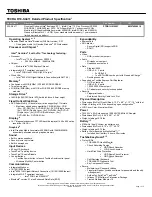
User’s Manual
Glossary-7
Glossary
erase:
See delete.
escape:
1) A code (ASCII code 27), signaling the computer that what
follows are commands; used with peripheral devices such as
printers and modems.
2) A means of aborting the task currently in progress.
escape guard time:
A time before and after an escape code is sent to the
modem which distinguishes between escapes that are part of the
transmitted data, and escapes that are intended as a command to
the modem.
execute:
To interpret and execute an instruction.
F
fast infrared:
An industry standard that enables cableless infrared serial
data transfer at speeds of up to 4 Mbps.
file:
A collection of related information; a file can contain data, programs, or
both.
fingerprint sensor:
The fingerprint sensor compares and analyzes the
unique characteristics in a fingerprint.
firmware:
A set of instructions built into the hardware which controls and
directs a microprocessor’s activities.
flash memory:
Non-volatile memory that can be written to as well as read.
Information in flash memory remains whether or not the computer is
receiving power. This type of memory is used to retain your
fingerprint data.
See also
memory. Compare RAM and ROM.
floppy diskette:
A removable disk that stores magnetically encoded data.
floppy diskette drive (FDD):
An electromechanical device that reads and
writes to floppy diskettes.
folder:
An icon in Windows used to store documents or other folders.
format:
The process of readying a blank disk for its first use. Formatting
establishes the structure of the disk that the operating system
expects before it writes files or programs onto the disk.
function keys:
The keys labeled
F1
through
F12
that tell the computer to
perform certain functions.
G
gigabyte (GB):
A unit of data storage equal to 1024 megabytes.
See also
megabyte.
graphics:
Drawings, pictures, or other images, such as charts or graphs, to
present information.










































